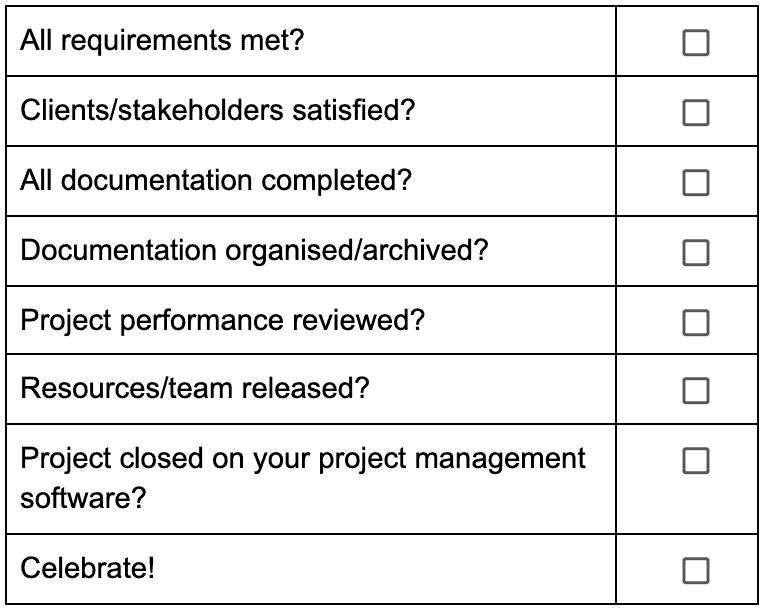Last updated on 9th May 2024
In this article we’re going to go through everything you need to know about project closure.
Opening projects can be really exciting, and so can working on them, but project closure doesn’t get talked about as much. However, it’s still an important aspect of successful project management.
Closing projects correctly can help you to learn from any mistakes so you can avoid repeating them in the future.
A great project closure can also increase client satisfaction. After all, this is the last communication you have with them, so it should be organised and professional.
Ready to find out more about project closure? Let’s jump into our complete guide!
What is project closure? (Definition)
Project closure is the last step of managing a project. This is where you finalise all of your tasks, make sure all of your deliverables have been reviewed and completed, and achieve final sign off and approval from stakeholders and/or clients.
It’s also an opportunity for reflection. You can review your project and find out what went well and what you would change if you were to start the project again from scratch. This can help to inform future projects and ensure things run smoothly in your business.
This process of reflection is one of the reasons why project closure is so important. But it’s equally important to have a formal project closure process so that you optimise resource utilisation, ensure customer satisfaction, and minimise risks that could arise with leaving a project open-ended.
Project closure examples
There are several reasons why you might close a project. Here, we’ll take a look at 5 project closure examples.
1. Objectives have been achieved
If you’re managing projects correctly then this is hopefully going to be your most likely reason for closing a project.
When all objectives have been achieved, and you’ve completed everything you needed to, it’s time to close the project and move on to the next one!
2. Risk mitigation
It’s also essential to close projects so that you don’t expose your company to potential risks and unresolved issues.
Issues that could occur from projects being left open include: stakeholder confusion and communication errors, financial implications (caused by things like tying up resources and ongoing project maintenance), and even scope creep.
3. Resource optimisation
As a project manager, you likely already know that active projects take up a lot of time, costs, and resources.
When your project is complete, it’s important to close it fully so that you can free up those resources and make them available for other projects.
4. Changing scopes
It’s so important that projects remain within the scope originally agreed upon. Scope creep can be really damaging and result in extra costs and disgruntled clients. If a project scope has changed so much that it doesn’t resemble what was initially agreed upon at the start of the project, then it’s best to close the project and open a new one.
For example, if you started a project for creating blog content for a client and the direction shifted towards creating an explainer video. The change to the project scope is so vast that it’s essentially a different project – so you might as well treat it like one to avoid confusion!
If you’re using a project management tool, like Project.co, this is super easy to do. On our platform, you can easily delete or complete a project at any time. If you’re closing a project because the scope has changed, we recommend marking it as ‘complete’ instead of deleting it, because then you’ll be able to access previous information if you need it.

If you still have uncompleted projects on the task, Project.co will remind you of this to make sure you’re still happy to mark the project as complete. When you do so, you’ll see a lock symbol appear next to the project name.
Next, you’re going to want to open a new project. This is also easy. You just hit the +Create New button at the top of the page.

You can link to your previous project in the project description to remind everyone why this new project exists.
5. Team recognition
Closing a project is – more often than not – a sign of a job well done, so it should be a cause for celebration!
Whenever you successfully close off a project, be sure to give your project team the recognition they deserve. According to our Employee Engagement Statistics 2022, almost 20% of people say they never, or almost never, receive any recognition at work.
How to close a project (in 5 steps)
1. Confirm completion with the client or stakeholder
The first step to closing a project should be to get confirmation from key stakeholders or clients that they are indeed happy to consider the project complete.
All this takes is a quick message to ensure everyone is happy and has no more feedback to share or changes to make to the project.
Project.co’s Discussion tool makes this simple:

It works just like any other messaging platform and ensures that all of your messages remain in one centralised location.
You’ll also have the entirety of your project conversation to scroll back through, dated and time-stamped. This is perfect for auditing or reviewing past project performance.
2. Conduct a project review
Next, start reviewing your project with a critical eye. Ask yourself:
- What went well?
- What went wrong?
- What would we do differently next time?
It might seem like a bit of a fluffy task, but it’s worth taking the time out to do this. Only by conducting a project review will you be able to improve future projects and ultimately increase the efficiency of your business.
Evaluate everything from team performance, to project scope, and budget – and see if anything stands out. If you found that you were close to going over budget, perhaps you need to charge clients more for your projects in the future.
Similarly, if you found that you had a lot of conversations with the client about project scope then perhaps you weren’t clear enough in your initial discussions and could benefit from revisiting your briefing documentation.
The list of potential future issues that could be resolved by a solid project review is practically endless. So don’t be afraid to really get in there and ask yourself the tough questions!
3. Complete all paperwork
A crucial component of completing a project is to fill out all of your paperwork, and store it somewhere safe.
This means gathering any signatures you require from stakeholders, making sure there are no outstanding invoices, and essentially just ensuring you’ve dotted all the ‘i’s and crossed all the ‘t’s before you close your project forever.
Project.co makes it easy to share documentation with everyone involved in your project. All you need to do is attach files to your comments or upload them directly to the Files tool.
Then, regardless of where they are in the world, your project stakeholders can download the files and do whatever it is they need to do!

We also make paying invoices simple and secure. All you need to do is connect your Stripe or PayPal to Project.co, and you’ll be able to take payments in multiple currencies, and get paid directly to your account.
4. Release resources
Another essential part of project closure is freeing up your team to work on other projects. As you complete all of your final tasks, you can close any contracts you have with freelancers and also give your internal team the go ahead to consider their project work done.
The Tasks tool within Project.co makes this crystal clear for everyone. Tasks can be assigned to different groups and people, and also given a date and status.

When a task has been done, the person assigned to the task just needs to mark it as complete and this will be recorded in the project.
As the project manager, you can keep an eye on everyone’s tasks and ensure everything is staying on track with your project.
5. Archive documentation
One of the final things you should do when closing a project is make sure you save all of your project-related documentation in a safe space.
Even though you’re closing the project, you never know when you might need to refer back to this information. It can be important for audits or to settle any disputes with past clients, and it can also just be a good reminder of the projects you’ve worked on.
You can look back over past projects and see how you used to manage things, how far you’ve come, and also if you’ve forgotten anything along the way that you’d like to start implementing again.
Bonus step: Celebrate!
We touched on this briefly above, but it’s worth mentioning again. The completion of a project should be cause for celebration. So don’t forget to congratulate your team and reward them for a job well done.
This doesn’t need to be huge. Even a small gesture of gratitude can be a great way to boost morale and increase job satisfaction.
Project closure checklist
Feel free to use this handy checklist when closing off your projects to make sure you’ve completed everything you need to!

Final thoughts
We hope this complete guide highlighted the importance of closing projects properly to keep your business running efficiently.
But, of course, project closure is just one aspect of project management. There are many more things you can do to ensure your projects are successful.
Check out this article to find out more: Ultimate Guide to Project Management for Teams.


